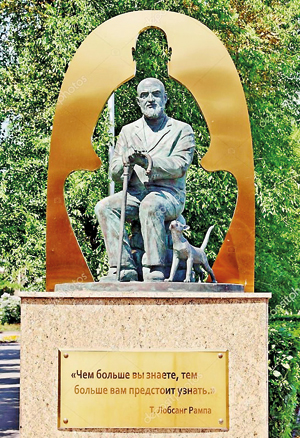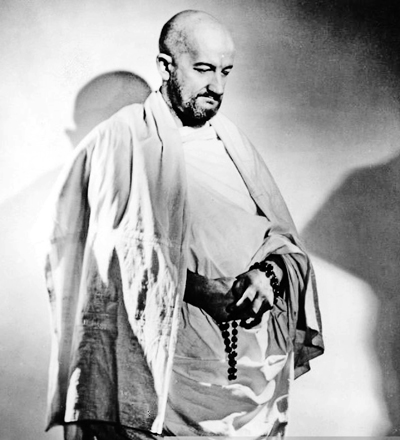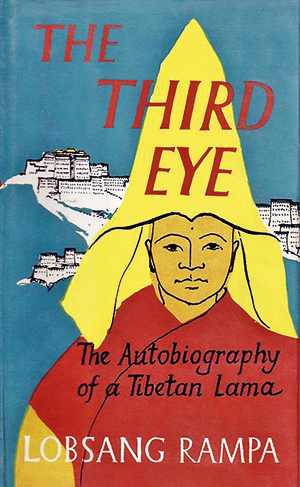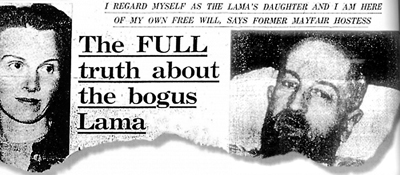Blind faith in the third eye

The monument to Lobsang Rampa in a public park in Russia
The Buddha founded the bhikkhu and bhikkuni Sangha to offer the optimum environment in which to pursue the highest spiritual goal – attaining Nirvana. However, from almost the very beginning some have been attracted to the Sangha for very different reasons – to escape from poverty, to have an easy life, to attain academic distinction then disrobe and get a good job– being some of them. A few have even entered the Sangha for nefarious reasons – to use it as a cover for cheating the gullible and making money. The Vinaya contains several examples of this.
It took at least a century after Buddhism became known in the West before it became clear that it was not a mystical system based on magic and supernatural powers. And even when a better knowledge of it was available groups such as the Theosophical Society continued to promote Madam Blavatsky’s so-called ‘esoteric Buddhism’; an untidy mixture of Western occultism, Asian superstitions and a sprinkling of authentic Buddhism. This impression of Buddhism is still current among some Westerners and some people are ready victims to frauds and con-men posing as Buddhists or even as monks.
One such person was Cyril Henry Hoskin. Born in England in 1910, he was apprenticed to a plumber when young and worked as one for several decades. Later he made trusses worn by men suffering from hernias. Up until the early 1950s his life seems to have been unremarkable but then beliefs and notions he had probably held for many years started to manifest themselves in his behaviour. His neighbours noticed that he started dressing in a strange, slightly oriental attire, that he had shaved his head and claimed that his real name was Dr. Kuon Suo and that he was Chinese. The English are used to eccentrics and it seems no one took much notice of him.
In 1956, the publishers Secker and Warburg in London received the manuscript of a book titled ‘The Third Eye’ written by a Tibetan Lama named Lobsang Rama. The book told of the Lama’s life in Tibet and his training as a monk which included surgically opening a ‘third eye’ in his forehead thereby giving him clairvoyant powers. Intrigued, they decided to publish it thinking that as Tibet had been in the news because of the recent Chinese invasion of Tibet, it might boost sales.

Cyril Hoskin alias Lobsang Rampa in 1964
But the editor was somewhat sceptical about the book’s authenticity and wrote to Rampa asking him to come for an interview. When the editor saw him and heard him speak it was clear that he was an ordinary working class Englishman. Before the interview the editor had shown the manuscript to some Tibetan experts and they had told him the book’s story was a fraud; they also taught him how to say ‘Did you have a safe journey’ in Tibetan.
At the beginning of the interview the editor addressed Rampa with these words but he had no idea what was being said to him. It was clear that Lobsang Rampa was an imposter. Nonetheless, the book was a good story so Secker and Warburg published it with a note saying that the story could not be verified.
Almost instantly it became a bestseller, receiving favourable reviews in several leading newspapers. The influential Times Literary Supplement called it “almost a masterpiece” and it created much interest among the general public. However Hugh Richardson and Heinrich Harrer, amongst the few Westerners who had actually lived in Tibet, poured scorn on the book, pointing out its innumerable errors about Tibetan language, manners and customs, and Buddhist monastic life. Both affirmed that there was no such thing as an operation opening a so-called ‘third eye.’ Nonetheless, the book sold 300,000 copies in the first 18 months; it has been continually in print ever since and has been translated into 40 languages.
But the public were not the only people taking an interest in Rampa. So was Scotland Yard. Their inquiries from the Home Office showed that no Tibetan passport holder had come to Britain for many years and so one day the police came calling on Lama Rampa asking to see his passport. A few days later he moved to Dublin. A group of concerned Buddhists and Tibetologists were interested to find out the truth about Rampa too and so they hired a private investigator. The investigator uncovered Rampa’s real name and doings and also that he had never left the British Isles. He also tracked him down and confronted him.

The first edition of Hoskin’s famous book
Rampa had a bizarre story to satisfy all the questions. Yes he admitted, his real name was Cyril Hoskin but a few years previously he had fallen out of a tree while trying to photograph birds and been knocked unconscious. When he recovered he found that his consciousness had been knocked out of his brain and the consciousness of a Tibetan Lama (the Tibetan word for a monk) had replaced it, so that while physically he was Cyril Hoskin in all other respects he was actually the Tibetan monk Lobsang Rampa. The private investigator produced a piece of paper with Buddhist stanzas in Tibetan script on it and asked Rampa to read it. When he couldn’t the investigator asked him why, if he had a detailed memory of other aspects of his life in Tibet, he couldn’t read his own language. Rampa had no answer for this and asked the investigator to leave. On February 3, 1957 the headlines of London’s Daily Express read, ‘The Full Truth About the Bogus Lama’.
Although Lobsang Rampa was no Tibetan monk, he did have miraculous powers, or at least good luck, albeit with the help of gullible and naive people. Undaunted by the exposé in the press he wrote a second book, Doctor from Lhasa, supposedly a continuation of his autobiography, which also sold well. By now financially well off for the first time in his life he moved to Canada and over the next few decades turned out 18 other books, each making more and more bizarre unbelievable claims, including his ability to travel to other planets through his astral powers.
Over the years his books have sold in the millions and he has hundreds of thousands, perhaps several million followers, who believe implicitly in the tall tales he told. The overwhelming evidence that he was really only an English plumber with a vivid imagination does not seem to diminish his standing in their eyes. There have been several biographies of him presenting him as a great mystic and in Russia there is actually a public monument to him! A miracle indeed!
Hoskins was never properly ordained as a monk despite posing as one. Was he a complete fraud, was he just deluded or was he a mixture of both? Personally I favour this third option. Was he harmful? The people who bought his books were never coerced into doing so. But there is no doubt that he did do great harm to Buddhism and that his books continue to do so. Many people believe that Buddhist practice allows one to see auras, travel to other planets, levitate and contact flying saucers, that it is all about astrology, gazing at crystals and communicating with the dead. Some 20 years ago a young man in Germany was rushed to hospital after he used a knife to try to open his ‘third eye’. Fortunately he survived but the newspapers were full of reports saying that this was a ‘Buddhist practice’.

Hoskin was finally exposed as a fraud in 1957
Several genuine Tibetan monks teaching Buddhists in the West have told me that it is not uncommon for people to come to them asking if they, the monks, can teach them how to open their third eye. When the monks tell them that this has nothing to do with Buddhism the people often go away angry or annoyed that the monks would not share their “esoteric knowledge” with them.
Lobsang Rampa has been a major reason why many Westerners and even a good number of ill-informed Asian Buddhists associate Buddhism with New Age and pseudo-mystical nonsense rather than what it is really about – kindness, gentleness, clear-mindedness and wisdom.
As for Cyril Henry Hoskin, he died in Calgary in Canada in 1981 aged 70.


